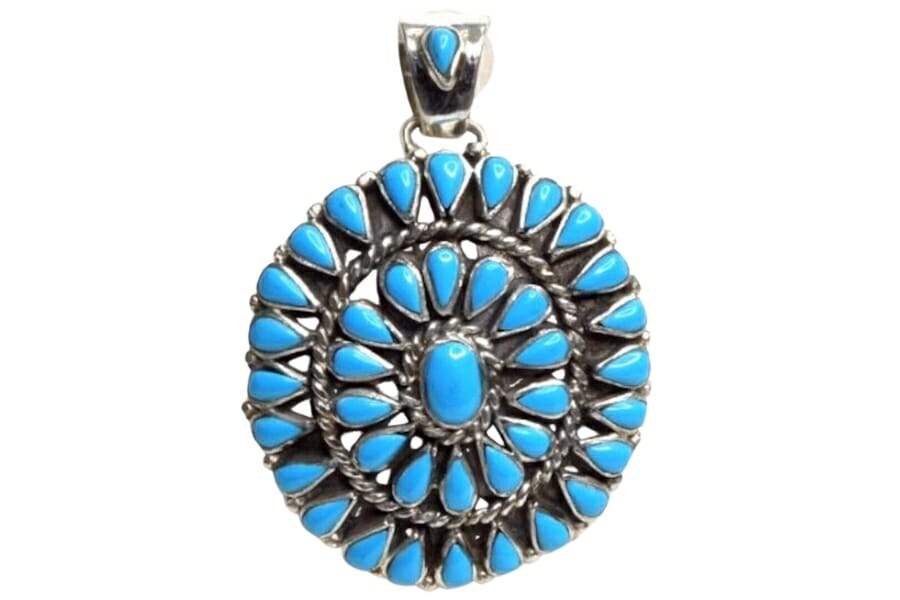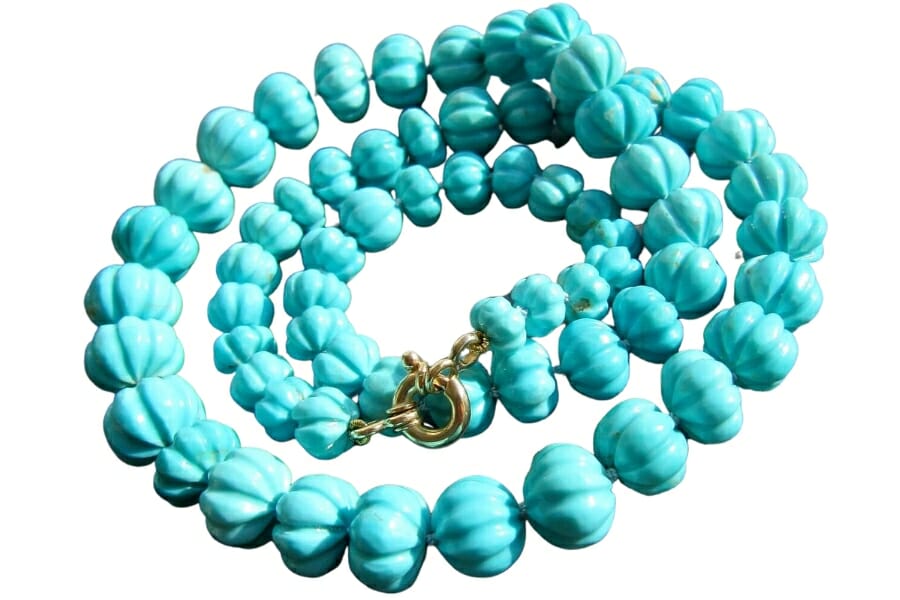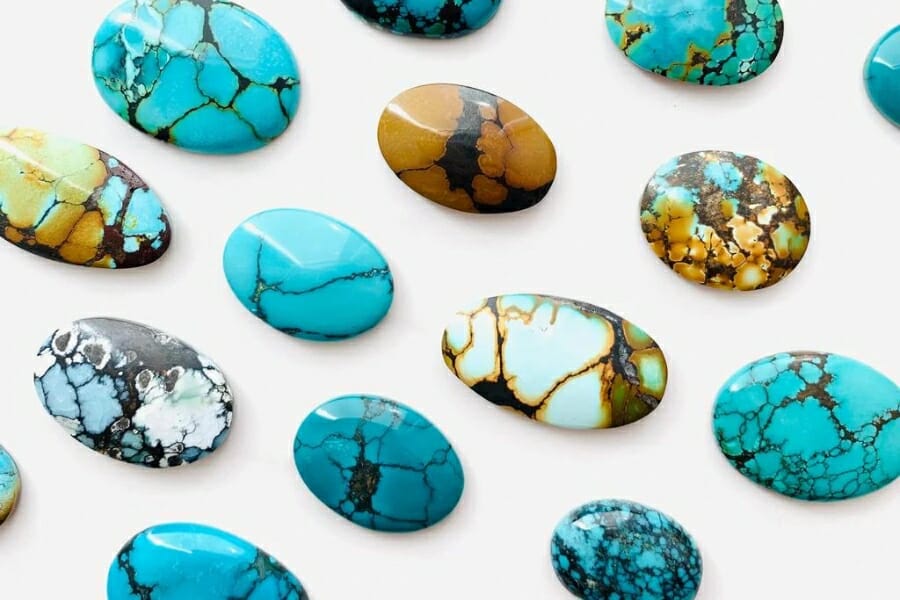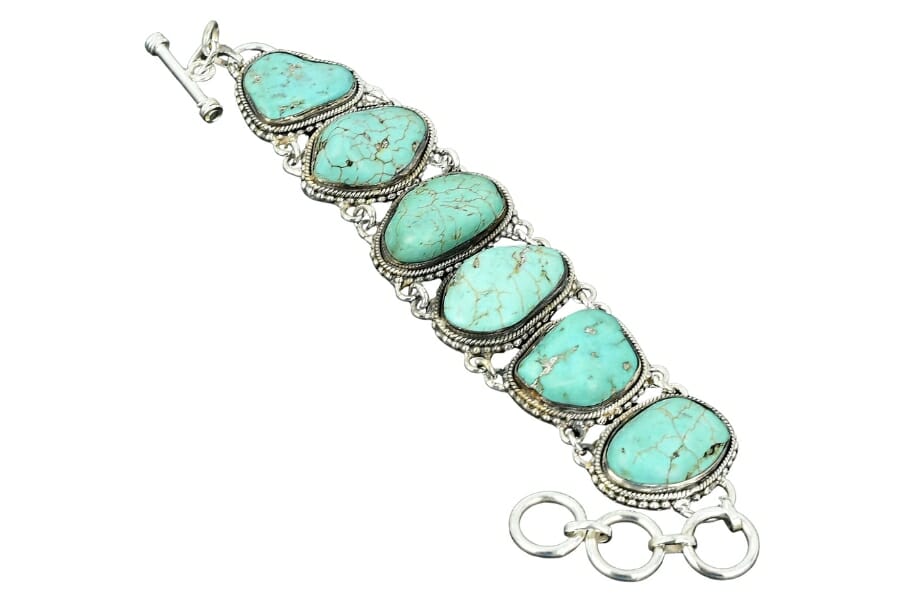Turquoise is a beautiful gemstone that captures the sky and the sea. It’s used to decorate everything from high-end jewelry to cultural artifacts. Diamonds and gold usually get all the attention, but turquoise has its unique charm.
If you’re thinking all turquoise are created equal, think again! This eye-catching mineral has subtle differences that can make one piece a collector’s dream and another just a pretty stone.
Let’s dive into the fascinating world of turquoise to find out what sets the price bar – from the role of geography and mineral composition to the impact of history and craftsmanship. Trust us, this gemstone has more than just good looks!
What Turquoise Is
Turquoise is a mineral that ranges from blue to green. It mostly comprises copper, aluminum, and phosphorus, which water holds together. It has been used for thousands of years to decorate and for spiritual purposes.
It’s often set in jewelry or used in ritual objects. Each piece of turquoise is unique because of its color, matrix patterns, and origin. This makes each one a small treasure in its own right.
We’ve written down how much each type of turquoise costs. Different types of turquoise contain other trace elements; they aren’t the only types but are the most common.
Bisbee Turquoise

Bisbee turquoise is a very popular type of turquoise because of its rich, deep blue colors, often paired with a unique reddish-brown matrix. It comes from the Arizona Bisbee mine, which used to be a copper mine but is no longer in operation for turquoise mining.
Its scarcity adds layer of value and desirability to this already exceptional stone. Its intricate matrix patterns often include shades of brown, black, or gold, creating a visually striking contrast with the gem’s vibrant blue color.
How much is a Bisbee turquoise worth
The price of a Brisbee turquoise can vary depending on several factors, such as size, quality, color, and matrix pattern. This type of turquoise can range from approximately $20 to $40 per carat.
Blue Turquoise

The most famous color of this beautiful stone is probably blue turquoise, which makes people think of blue skies and tropical seas. Blue turquoise has fascinated people for a long time because of its bright blue color, ranging from light sky blue to deep cobalt.
The bright blue color is mainly caused by the copper ions that are part of the mineral. Blue turquoise comes from places like the Kingman mine in Arizona or portions of Iran. It’s known for its high quality and timeless beauty.
How much is a blue turquoise worth
High-quality blue turquoise could cost anywhere from $7 to $10 per carat, but some pieces, especially those from famous mines like the Kingman or those with Persian roots, can sell from much more.
Green Turquoise

Green turquoise is a lush, earthy alternative to blue turquoise. Its colors range from light mint to dark forest green. Most of the time, this unusual color comes from higher levels of iron or chromium in the stone, which replace some of the copper that gives turquoise its blue color.
Like blue turquoise, green varieties can have complex matrix patterns that make each piece unique and exciting. These patterns can be anything from golden brown to dark black. They make a rich tapestry that adds to the natural beauty of the stone.
How much is green turquoise worth
Green turquoise of good quality can range between $2 to $7 per carat. But like blue turquoise, high-quality and rare pieces can sell for a higher price.
Lander Blue Turquoise

People often say that Lander Blue turquoise is the most rare and desirable turquoise type. This turquoise comes from a small, now-empty mine near Lander, Wyoming.
It’s known for having a spiderweb-like pattern against a bright blue background. The mine was only open for a short time in the 1970s and only made a small amount of high-quality turquoise.
This makes existing pieces of Lander Blue very rare and highly sought after. Due to how hard it is to find and how beautiful it is, this turquoise is almost a myth among collectors and gem lovers.
How much is Lander Blue turquoise worth
Depending on the stone’s quality, Lander Blue turquoise prices are between $300 to $500 per carat. Other specimens can even reach $1000 per carat!
Morenci Turquoise

Morenci turquoise comes from the Morenci copper mine in southeastern Arizona, one of the biggest copper mines in the United States. This type of turquoise is very popular because of its deep blue color.
It’s often spotted or veined with pyrite, which gives the stone a unique metallic shine. Pyrite is a distinguishing feature of Morenci turquoise that sets it apart from other kinds. Also, its matrix patterns, usually black, silver, or gold, can create striking effects that pair well with its blue hue.
How much is Morenci turquoise worth
Morenci turquoise is premium because of its high quality and unique pyrite features. It sells for approximately $10 to $50 per carat.
Sleeping Beauty Turquoise

Sleeping Beauty turquoise is known for its pure, sky-blue color that often doesn’t have any signs of a matrix or veining. This clean, even color is highly valued in the turquoise market.
This type of turquoise got its name from the Sleeping Beauty Mine in Globe, Arizona, where it was mainly mined. Since the mine stopped making turquoise, it has become a legend. The mine started as a copper mine, but the turquoise it made quickly became famous for its unique, flawless look and beautiful color.
The absence of a matrix in most Sleeping Beauty turquoise makes it highly desirable for jewelry that calls for consistent color and texture, such as inlay work and bead-making. It’s often chosen for pieces where the pure blue can stand out and make a bold statement.
How much is Sleeping Beauty turquoise worth
Sleeping Beauty turquoise can be worth a lot of money because it is rare and has unique qualities. The fact that the Sleeping Beauty Mine is closed has made it even rarer. This type of turquoise could be worth anywhere between $50 to $200, though some pieces that are especially nice or big could be worth more.
Why Turquoise Is So Expensive

People have loved turquoise for thousands of years because its colors remind them of the sky and the earth. This semiprecious gemstone is valued not only for its beauty but also for its deep cultural and historical meanings.
Ancient peoples, from the Egyptians to the Aztecs, wore turquoise jewelry on their kings and queens because they thought its bright blue and green colors were signs of divine power and protection.
Native American tribes, especially those in the American Southwest, believe it can heal and link heaven and earth. In addition to its cultural significance, each piece is unique because of its different tones, matrix patterns, and ability to age beautifully.
Its timeless appeal comes from the fact that it can be used to make different kinds of jewelry, like a simple silver cuff or an elegant gold pendant. Also, the value of high-quality turquoise keeps increasing because mines are running out, and more people want it.
Turquoise is more than just a stone. It’s a beautiful example of nature’s work and a beacon of style beyond time and place. When you appreciate turquoise, you understand its beauty, history, and the important stories it has been and still is a part of.
How To Determine The Value Of Turquoise

Most of the time, the price of a piece of turquoise depends on a few important factors:
Color
The presence and pattern of the matrix, which are the veins or patches running through the stone, can also influence value. A well-distributed, attractive matrix is often highly prized, especially if it forms unique, intricate patterns.
Matrix
Turquoise with consistent color and minimal spotting or unwanted marks is generally more valuable. Stones with uneven colors or unattractive splotches are typically less prized.
Clarity
Larger, high-quality stones are usually more valuable on a per-carat basis. However, the value doesn’t always scale linearly with size; other factors like color and clarity must also be considered.
Treatment
Natural, untreated turquoise is generally more valuable than treated or stabilized stones. Treatments can include filling imperfections with resin or enhancing color artificially, which usually decreases the stone’s value.
Origin
The source of the turquoise can significantly affect its price. Certain mines, such as the Sleeping Beauty Mine in Arizona or the Lander Blue Mine in Wyoming, are renowned for producing high-quality turquoise; stones from these mines often command a premium.
Rarity
Some types of turquoise, like Lander Blue, are extremely rare and expensive. Rarity is often a result of high demand and limited availability.
Craftsmanship
If the turquoise is part of a piece of jewelry, the quality of the craftsmanship and any accompanying materials (like gold or silver settings) will also influence its price.
Market Trends
Like any other gemstone, the popularity of certain types or colors of turquoise can ebb and flow with fashion trends, which can affect demand and price.
Turquoise Price By Type

To figure out how much a turquoise is worth and how much it costs, you need to know all about its factors. Along with the state of the market and the diamond’s certification, these things are very important when figuring out how much a turquoise is worth.
The following list includes the most common turquoise types’ recent prices.
Turquoise values by type
| Color | Location | Price (Per Carat) |
| Bisbee turquoise | Any | $20 to $40 |
| Blue turquoise | Any | $7 to $10 |
| Green turquoise | Any | $2 to $7 |
| Lander Blue turquoise | Any | $300 to $500 |
| Morenci turquoise | Any | $10 to $50 |
| Sleeping Beauty | Any | $50 to $200 |
As can be seen, the value and price of different types of turquoise vary. Let’s see how much turquoise costs in other units.
Turquoise pricing by unit of measurement
| Measurement | Price |
| A carat of turquoise | $2 to $500 |
| A gram of turquoise | $10 to $2,500 |
| An ounce of turquoise | $280 to $70,870 |
| A kilogram of turquoise | $10,000 to $2,500,000 |
| A pound of turquoise | $4540 to $1,133,980 |
| A ton of turquoise | $9,071,850 to $2,267,962,500 |
The Most Expensive Turquoise

Iran’s Khorasan Blue Rock, also called “Persian Turquoise,” is one of the world’s oldest and most respected places to find high-quality turquoise. This turquoise comes from northeastern Iran, especially the Nishapur district in Khorasan.
It’s known for its rich, sky-blue color, often free of matrix or veins, giving it a clean, uniform look. Its bright color has been compared to the color of a robin’s egg, often considered the best example of the turquoise color.
Several factors contribute to its high cost. The purity and consistency of the blue color are extremely rare in turquoise, making it a collector’s dream.
Additionally, the geopolitical context adds layers of complexity and rarity; international sanctions against Iran have made the export and trade of this gemstone challenging, contributing to its limited availability and increasing its price.
Furthermore, Persian Turquoise has a rich cultural heritage deeply integrated into Iranian art, architecture, and mythology. This cultural and historical weight adds intangible value to the already exceptional mineral.
Because of these factors, Khorasan Blue Rock Turquoise is an aesthetic marvel and a gem imbued with a deep sense of history and rarity, justifying its premium price point of $218,500.
How To Get An Appraisal On Your Turquoise

After reading our guide, you’ll know how much your turquoise is worth and how much it generally costs. Still, the best way to find out is to have a professional do an appraisal. They will be able to discover good and bad qualities that would be hard for a person without experience to notice.
Look for a certified gemologist or a jewelry appraiser specializing in colored gemstones, especially turquoise, if possible. Certifications from reputable groups like the American Gem Society (AGS) or the Gemological Institute of America (GIA) can show how good an appraiser is.
Don’t be afraid to ask your friends, family, or people in online forums for suggestions. You can also read reviews or ask to talk to the appraiser’s previous clients about their reputation.
Many appraisers will give you an initial consultation for free or for a small fee. Use this time to ask questions and learn how things work. Make sure to ask how much the appraisal will cost as well.
Bring any paperwork about where the turquoise came from, how it was treated, or how it was appraised. This can be very helpful for the appraiser.
The appraiser will carefully examine the turquoise, often with tools like microscopes, spectroscopes, and other gemological tools to judge its quality and features.
Once the appraisal is done, you should get a formal document with all the information about the turquoise, including an estimate of how much it is worth on the market. This appraisal certificate should be thorough and list everything that was looked at.


